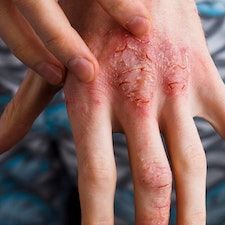News
Article
Patient-Oriented Scoring System for Atopic Dermatitis Shown to be Reliable, Effective
Author(s):
The use of this scoring system twice-per-week may help patients to better manage their mild-to-moderate atopic dermatitis.

The Patient-Oriented Scoring of Atopic Dermatitis’s (PO-SCORAD) demonstrated reliability appears to justify more extensive use in clinical settings compared to other scoring systems, according to new findings, given that its twice-per-week use may aid the management of atopic dermatitis (AD).1
These findings resulted from new research conducted to expand upon the limited data on SCORAD and PO-SCORAD’s use in patients with AD, with the study’s investigators working to confirm the potential correlations seen between results from PO-SCORAD, SCORAD, the Patient-Oriented Eczema Measure (POEM), and Investigator’s Global Assessment (IGA).2
“Recently, Chopra et al. provided new data on SCORAD strata in adults but data in children are still lacking, especially in mild-to-moderate AD patients which represents the highest proportion of affected patients in real-life,” the investigators wrote.
The new study into PO-SCORAD’s use for AD was authored by Sébastien Barbarot, MD, PhD, from Nantes Université’s Department of Dermatology at CHU Nantes in France.
Overall, Barbarot and colleagues sought to assess the correlation of PO-SCORAD with SCORAD, and the other systems for children that had mild-to-moderate cases of AD, to examine SCORAD’s interoperability, and to assess how PO-SCORAD might help in clinical practice settings.
Background and Findings
The study’s investigators used a retrospective study and assessed data from 335 participants in the age range of 2 - 6 years, with diagnoses of mild-to-moderate AD according to the criteria from the UK Working Party.
With the research having been conducted in Europe, the team used a randomized, parallel-group study design with 2 emollient groups and a single non-emollient group.
The research team adhered to Good Clinical Practice standards and they received ethical approval as well as parental consent for the data. In the beginning, the young patients were given a potent treatment of topical corticosteroids until the resolution of their inflammatory signs.
Subsequently, the investigators randomized the study participants into 3 arms for a 12-week time period: 1 of the groups received V0034CR emollient, the second was given a reference emollient (Atopiclair), and the other received no emollient.
Flares which occurred at the time of treatment were managed through the use of a topical corticosteroid with moderate potency.
The investigators found that eligible individuals had documented flare treatments that took place within half a year and mild-to-moderate AD cases with SCORAD scores that placed between 15 and 40.
The team’s assessments, which included scores from IGA, SCORAD, PO-SCORAD, and POEM, were carried out at several different study visits and at the same time as flare-related assessments.
The overall study design was shown to be consistent with ethical guidelines and clinical standards, and it involved a cohort made up of young patients meeting specific criteria for AD.
The investigators were able to observe strong correlations between the results of the PO-SCORAD and SCORAD systems (correlation coefficient r=0.874), PO-SCORAD and POEM (r=0.734).
They were also observed between PO-SCORAD and IGA (r=0.613), with the team noting that the most optimal alignment (‘k’ statistic: 0.68) between IGA and SCORAD classes was found in specific SCORAD categories: <12 for clear or almost clear, 12 - 25 for mild, and ≥25 for moderate or severe.
Additionally, the research team noted that the area below the curve for the PO-SCORAD system over the course of 8 weeks was found to be much greater than that of the SCORAD system (P=0.0002). This allowed for increased accuracy estimates of severity of disease in between patient visits, and individuals with experiences of a flare in the subsequent week showed uniquely higher scores in the PO-SCORAD system a week prior to flares (P<0.0001).
The investigators added that moderate erythema was found to have been the most substantial predictor of patients’ reported flares (P<0.0001).
“The PO-SCORAD is a robust, reliable, and easy-to-use PRO measure and one that now appears to warrant far greater utility in routine clinical practice,” they wrote. “The use of the PO-SCORAD twice-weekly may help the management of patients with mild-to-moderate AD.”
References
- Barbarot, S., Aubert, H., Stalder, J.-.-F., Roye, S. and Delarue, A. (2023), The Patient-Oriented Scoring of Atopic Dermatitis (PO-SCORAD) and SCORAD in young children: new data on interpretability and clinical usefulness. J Eur Acad Dermatol Venereol. Accepted Author Manuscript. https://doi.org/10.1111/jdv.19494.
- Oranje AP, Glazenburg EJ, Wolkerstorfer A et al. Practical issues on interpretation of scoring atopic dermatitis: the SCORAD index, objective SCORAD and the three-item severity score. Br J Dermatol 2007; 157:645–8.





